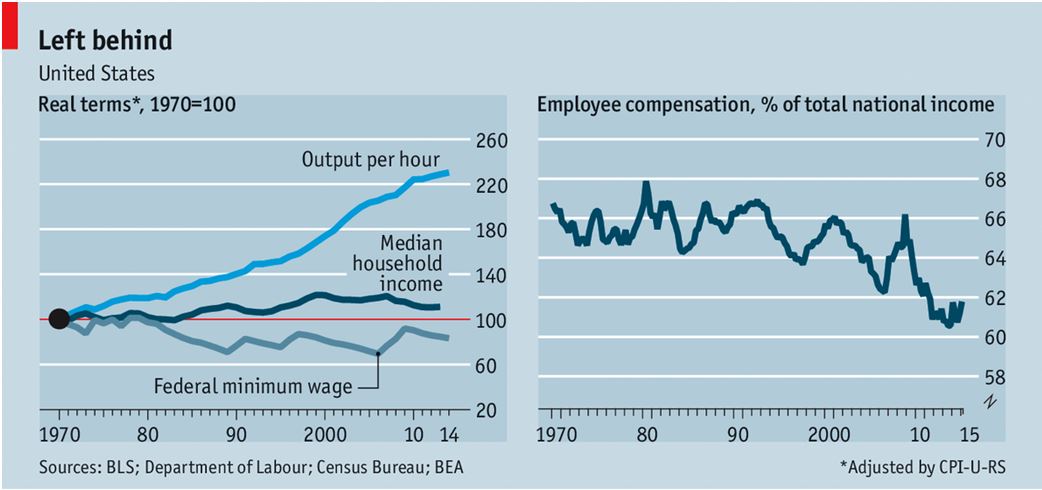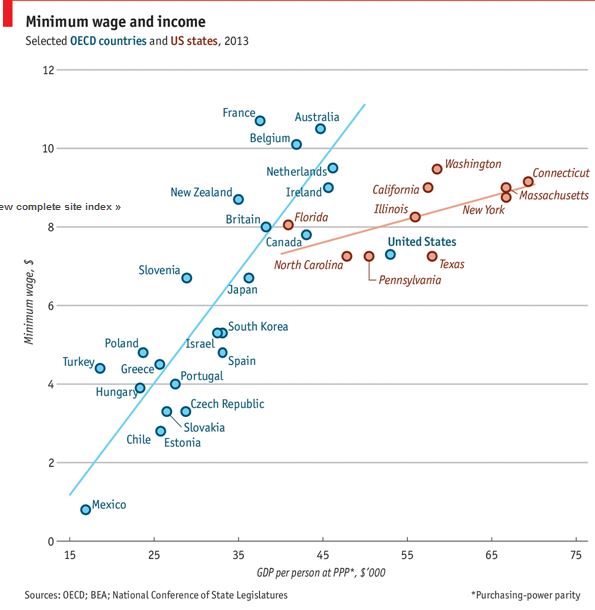WITH unemployment low, decent growth anticipated for this year and the Federal Reserve preparing to raise interest rates, America’s economy looks rosier. That has not stopped candidates for president from worrying about it. With the economy back on its feet, the presidential hopefuls want to address a longer-term condition: stagnant wages. Median household incomes remain lower in real terms than in 1989, and only 11% higher than in 1970. Talk of the death of the American dream is rife. The candidates have suggested a variety of reviving strategies, each of which reveals a different diagnosis of the underlying problem.
The first idea is to boost growth. Most economists reckon GDP rose by around an annualised 2.5% in the second quarter—strong, by today’s standards. But it lags the pace achieved, say, from 1996 to 2000, when annual growth topped 3.5%, and real median incomes grew by 10% to boot.
That is probably true, but the ambitious target has raised plenty of eyebrows among economists, many of whom think the economy’s potential for growth is permanently lower today. Mr Bush’s plan is light on details, but in an interview with a New Hampshire newspaper on July 8th he said part of the solution might be for Americans to work longer hours. The Democrats immediately lambasted him as out of touch; Americans already toil for longer than any other workers in the G7 group of large rich countries.
Mr Bush may have a point all the same. There are 6.4m Americans in part-time jobs who want to work full-time, up from 4.5m on the eve of the recession. The Federal Reserve reckons these workers form part of the slack in the labour market which holds wage growth down. Still, it is not clear what Mr Bush could do about this, were he to win the White House. Labour-market slack is a short-run issue that is usually the domain of the Fed.
A more promising approach is to try to boost productivity in the hours already worked—another natural way to get wages up. In a thoughtful speech on July 7th Marco Rubio, one of Mr Bush’s many rivals for the Republican nomination, focused on this route to riches. The plight of the middle class was not, he said, the result of a cyclical economic downturn. Instead, Americans need help adapting to the new world of high-tech jobs. Just as textile workers in the industrial revolution had to retrain to learn to use the power loom, and became richer as a result, Americans today will thrive only if they learn to harness the tools of the global techno-economy.
To that end, Mr Rubio wants to overhaul higher education. A four-year college course is unnecessary for many students, and too expensive for workers looking for new skills, he argues. Mr Rubio wants to make it easier to set up cheaper, shorter courses and break what he calls the “cartel” of colleges controlling accreditation. He would also introduce a new funding model for students, who could offer up a fixed percentage of their future incomes to investors willing to finance their studies.
Boosting skills and productivity is necessary to increase wages. But Hillary Clinton, the probable Democratic nominee, likes to point out that this is not, on its own, enough. Americans have not reaped the fruits of their labour in recent decades Since 1970, productivity has more than doubled, while median incomes have risen only 11% (see chart).
That makes the problem look like one of pie-cutting rather than pie-cooking. The labour share—the proportion of GDP that flows to the pockets of workers—has been in decline since the turn of the century, with capital gobbling up an increasing share of the economy’s spoils. Mrs Clinton wants to arrest this trend by encouraging firms to share profits with workers. She would offer a two-year tax credit to firms that do so, worth up to 15% of whatever was paid out. The hope is to nudge firms towards schemes that they will continue after the tax break is withdrawn. The firms may find this is good for them: there is strong evidence that profit-sharing boosts productivity, argues Joseph Blasi, an economist at Rutgers University who advised the Clinton campaign on the policy.
Pie-eyed
One problem is that wages may fall to offset the profit share. To begin with, this would be spotted easily. But over time it would be harder to detect (for instance, wages might grow at a slower pace with profit-sharing in place). The only way of ensuring that workers shared company profits in the long-run would be to encourage employee ownership of firms.
Mrs Clinton’s challengers on the left have a more rudimentary approach. Both Martin O’Malley, a former governor of Maryland, and Bernie Sanders, a senator from Vermont, say they will more than double the federal minimum wage from $7.25 to $15 an hour. Seattle, Los Angeles and San Francisco are already phasing in such a policy. On July 22nd a panel of experts recommended a $15 minimum wage for fast-food workers in New York. A much higher minimum wage would boost median incomes, because many low-wage workers are their household’s second earners. But the minimum wage is a blunt instrument, and economists know little about the long-run impact these increases would have on employment (see article).
The candidates do not seem short of ideas to improve the fortunes of average Americans. And the renewed focus on wages is welcome; economic growth matters little if it does not boost living standards. Most of the front-line candidates have correctly identified the causes of the malaise (Scott Walker, who sees no problem, is an exception). But slower growth, weak productivity and a declining labour share of income are global trends. The next president will need to fight all three.

From the print edition: United States